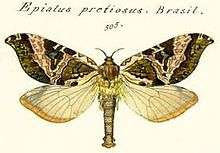Sthenopis pretiosus
| Sthenopis pretiosus | |
|---|---|
 | |
| Scientific classification | |
| Kingdom: | Animalia |
| Phylum: | Arthropoda |
| Class: | Insecta |
| Order: | Lepidoptera |
| Family: | Hepialidae |
| Genus: | Sthenopis |
| Species: | S. pretiosus |
| Binomial name | |
| Sthenopis pretiosus (Herrich-Schäffer, 1856) | |
| Synonyms | |

Sthenopis pretiosus, the gold-spotted ghost moth, is a species of moth of the family Hepialidae. It was first described by Herrich-Schäffer in 1856. It can be found in found Brazil, Venezuela and in the north-eastern United States and south-eastern Canada.
Naming history
Sthenopis pretiosus was independently discovered, named and described at least three times:
- It was first found in Brasil and described by Herrich-Schäffer in 1856 who called it Epialus pretiosus.[3] The type specimen of E. pretiosus has not been located.[2]
- It was also found in the north-eastern United States and south-eastern Canada and described by Grote in 1878, who called it Hepialus auratus which become Sthenopis auratus.
- It was also found in Venezuela and described by R. Pfitzner in 1906,[4] who called it Phassus eldorado. Latter R. Pfitzner published illustration of Phassus eldorado.[5] The holotype of P. eldorado is at the Senckenberg Museum in Frankfurt am Main.[2]
In 2015, Carlos G. C. Mielke and John R. Grehan concluded that Hepialus auratus Grote, 1878 and Phassus eldorado Pfitzner, 1906 are junior and subjective synonymies of Sthenopis pretiosus Herrich-Schaffer, [1856], and applied the rule of priority to change H. auratus and P. eldorado's names to Sthenopis pretiosus.
Description
The wingspan is 60–70 mm. The forewings are yellowish-brown with several gold spots and an indistinct whitish, pinkish, or silvery band overlaid with small angular patches. The hindwings are light yellowish-orange and unmarked.[6]
Food plants for this species include Athyrium, Dryopteris, and Matteuccia.
Bibliography
- Kirby, W. F. 1892. A synonymic catalogue of Lepidoptera Heterocera (moths). Vol. I, Sphinges and Bombyces. — London (Guerney & Jackson), Berlin (R. Friedländer), xii + 951 pp.
- Mielke, C.G.C. & Grehan, J. R. (2012): Catalogue of the Latin American Hepialidae with taxonomic remarks (Lepidoptera). NEVA (N.F.)32: 131–158.
- Mielke, C.G.C. & Grehan, J.R. 2016. Description of a new species of Phassus Walker, 1856 from Costa Rica, Pallas, gen. n., with a new species from Guatemala, and taxonomic notes on Sthenopis Packard, [1865] (Lepidoptera, Hepialidae). European Journal of Entomology 7: 113-134.
- Nielsen, E. S. & Robinson, G. S. 1983. Ghost moths of southern South America (Lepidoptera: Hepialidae). Entomograph 4: 1–192.
- Nielsen, E. S., Robinson, G. S. & Wagner, D. L. 2000. Ghost-moths of the world: a global inventory and bibliography of the Exoporia (Mnesarchaeoidea and Hepialoidea) (Lepidoptera). Journal of Natural History, London 34: 823–878.
- Robinson, G.S. & Nielsen, E. S. 1984. Hepialidae. In Heppner, J. B. (ed.), Atlas of Neotropical Lepidoptera. Checklist: Part 1. Micropterigoidea–Immoidea. — Den Haag (W. Junk), xxvii + 112 pp.
- Wagner, H. & Pfitzner, R. 1911. Hepialidae. In Aurivillius, C., & Wagner, H. (eds.), Lepidopterorum Catalogus 4. — Berlin (W. Junk), pp. 1–26.
References
- ↑ Nielsen, Ebbe S.; Robinson, Gaden S.; Wagner, David L. (2000). "Ghost-moths of the world: a global inventory and bibliography of the Exoporia (Mnesarchaeoidea and Hepialoidea) (Lepidoptera )" (PDF). Journal of Natural History. 34 (6): 823–878. doi:10.1080/002229300299282.
- 1 2 3 4 5 Grehan, John R.; Mielke, Carlos G. C. (Summer 2016). "Sthenopis auratus (Grote, 1878), a junior and subjective synonym of Sthenopis pretiosus (Herrich- Schaffer, [1856]) (Lepidoptera: Hepialidae)" (PDF). News of The Lepidopterists’ Society. 58 (2): 76–77. Retrieved 16 December 2016.
- ↑ Herrich-Schäffer, G. A. W. (1850–[1858]): Sammlung neuer oder wenig bekannter aussereuropäischer Schmetterlinge. — Regensburg (G. J. Manz), 84 pp., 120 pls.
- ↑ Pfitzner, R. (1906): Zwei neue Hepialiden aus Süd-Amerika. Deutsche Entomologische Zeitschrift “Iris”, 18: 276–277.
- ↑ Pfitzner, R. (1937–1938): Familie: Hepialidae, pp. 1289–1302, pls. 99–100 + 185. In: Seitz, A. (ed.) (1913–1940), Die Gross-Schmetterlinge der Erde 6. Band. Die Amerikanischen Spinner und Schwärmer. Stuttgart (A. Kernen).
- ↑ Bug Guide